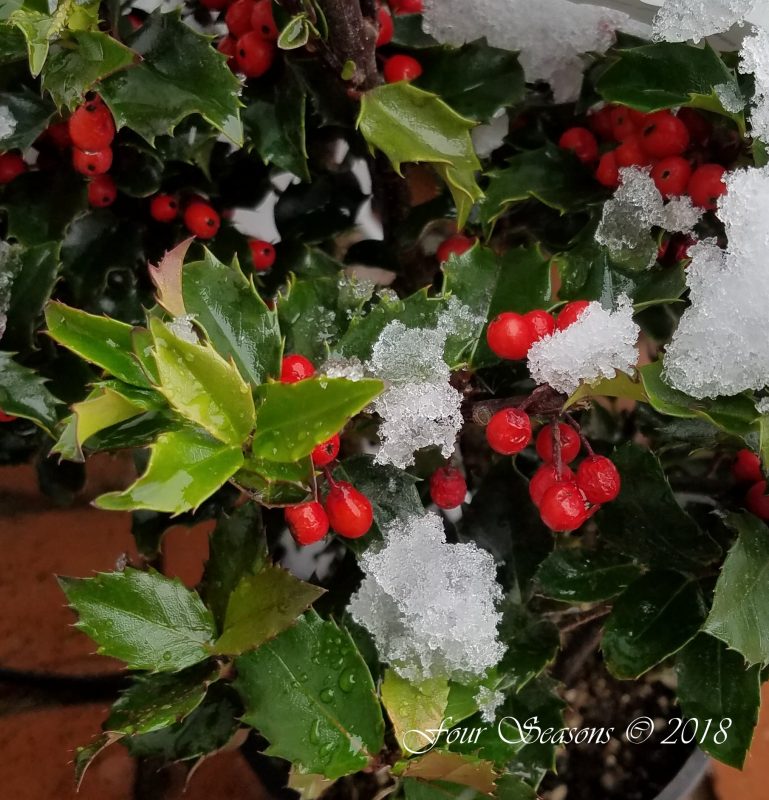It’s hard to think of the holidays without having the colors of green, red, and white immediately come to mind. These seasonal favorites are all colors that originated in nature and have come to be associated with the holiday season.
Green is the first color that I always associate with the holidays, perhaps because there is so much of it. Wreaths, Christmas trees, garland, roping, advent wreaths, and more all feature green predominantly in their design. Although no one can pinpoint a specific date when it began to be widely used, we do know that long before Christ was born and the advent of modern Christmas celebrations, the Druids used evergreens extensively during the winter months. They believed that it held some sort of magical power since it alone remained green and thriving when all the other plants had died off or dropped their leaves long before the short, dark days of winter. Because of this, evergreens were both worshiped and feared for the power it was perceived that they held.
Others thought that this green symbolized life and perhaps hope for spring throughout the winter months, particularly in Europe and the Advent wreaths that originated there are thought by some to be among the first uses of evergreens specifically for Christmas decorating. Although the colors of the candles used in these wreaths originally varied from church to church and from country to country, purple was used most often. Representative of hope, peace, and love, the final candle originally was usually red, representing the gift of Christ’s sacrifice on the cross though occasionally you will see a white candle in the wreath, symbolizing Jesus’ birth. Christmas trees, wreaths, roping, garlands, and more are other green holiday symbols which usually are fashioned from some variety of evergreens.
Holly is another plant that the ancients used widely. How could this plant not only thrive and remain green, but also produce beautiful red berries when most others were dormant? The only answer was that it must be magical! The Romans wove it into wreaths to mark the passing of winter solstice, the shortest day of the year, but because it remained in place after those celebrations, in time this plant came to be associated with Christmas.
Brilliant red poinsettias have come to represent and be among the beloved of holiday flowers although poinsettias have a much less ancient history as a symbol of Christmas. Brought to the United States in 1828 from Mexico by our ambassador Dr. Joel Poinsett, the plant there had been known as Flor de la Noche Buena, or Flower of the Holy or Blessed Night. It’s red, star shaped flower is supposed to remind us of the Star of Bethlehem. A Mexican legend speaks of a poor girl, who with no gift to offer Mary, picked some weeds growing along a roadside. The moment she placed them at Mary’s statue, they turned to brilliant poinsettia blooms. Although there are many varieties and colors, contrary to popular belief they are NOT poisonous, although consumption is not recommended!
Mistletoe combines the beauty of something green and living with snowy white berries and often brings giggles wherever it is hung. Seems kind of strange, doesn’t it- kissing under a plant? The custom of kissing under the mistletoe originates in ancient Rome where enemies reconciled under mistletoe. Another legend brings it to modern times from the Norsemen where it was sacred to Frigga, goddess of love. When her son Balder dreamed of his own death, she turned to the elements air, fire, water, earth and every animal and extracted a promise for them not to harm her son. She overlooked the mistletoe, a parasite hanging in oak and apple trees. When Balder was killed by Loki, god of evil, Frigga was the only one who was successful in bringing him back to life through the power of love. Legend has it that her tears turned into the berries on the mistletoe and she kissed each person who passed beneath it.
Sacred to the Druids, it was considered Pagan and forbidden in churches as a decoration there, yet it became a part of Christmas in many homes. Mistletoe is now considered a symbol of Christmas joy. Some of the superstitions surrounding it include that letting it fall to the ground is unlucky, that a girl standing under it cannot refuse to be kissed, and that one who goes unkissed cannot expect to be married the following year.
Although there are many other plants associated with the holiday season- laurel, rosemary, ivy, and blood red Christmas roses to name a few, evergreens, poinsettias and mistletoe are the ones you’ll see most often. Ah, the colors of Christmas! Whether they are natural or artificial, in hues of green, red, or white, may they decorate your home in abundance this holiday season!

